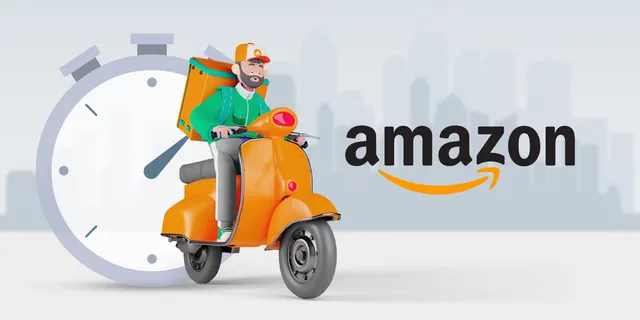
Amazon is set to revolutionize India’s quick commerce landscape by launching a 15-minute delivery service, starting with a pilot in Bengaluru. This bold move brings the e-commerce giant into direct competition with established players like Blinkit, Zepto, and Swiggy Instamart, intensifying the battle for dominance in the fast-growing sector. With the promise of ultra-fast delivery of everyday essentials, Amazon’s entry could disrupt the existing equilibrium and reshape consumer expectations.
Focus Keyword: Amazon 15-Minute Delivery
India’s quick commerce market is on an upward trajectory, with changing consumer behavior driving demand for speed and convenience. Amazon’s announcement signals its ambition to capture a slice of this lucrative pie, but can it dethrone the current leaders? Here’s an in-depth look at Amazon’s strategy, the competitive landscape, and what this means for consumers and competitors alike.
Amazon’s Strategy: What Sets It Apart
Amazon’s 15-minute delivery service, reportedly called “Tez” (although the name remains unconfirmed), aims to deliver groceries, personal care items, and other essentials faster than ever before. The service will leverage dark stores—small warehouses dedicated to fulfilling online orders—to meet the tight delivery timelines.
Samir Kumar, Amazon India’s country manager, announced the initiative during the company’s annual event, Smbhav, held in Delhi. He emphasized Amazon’s focus on “selection, value, and convenience” and highlighted the importance of addressing the increasing demand for ultra-fast deliveries. While the pilot project will begin in Bengaluru, further expansion will depend on its success.
Amazon already operates a two-hour delivery service under Amazon Fresh, which caters to grocery needs. The addition of a 15-minute option could make Amazon a formidable contender in quick commerce, attracting consumers seeking faster solutions.
Why Quick Commerce is the Next Big Thing
Quick commerce—defined by deliveries within minutes—has witnessed exponential growth in India. A Meta report highlights that 91% of Indian online consumers are aware of quick commerce platforms, with over half having used them recently. Key trends include:
- Increased Spending: 57% of users report spending more on quick commerce platforms, driven by the convenience of instant access to essentials.
- Popular Categories: Groceries, fresh produce, and personal care products dominate this segment, contrasting with traditional e-commerce’s focus on electronics and fashion.
- Urban Appeal: Quick commerce is particularly popular in urban areas, where busy lifestyles demand faster solutions.
Unlike traditional e-commerce, quick commerce fulfills urgent needs, making it indispensable for a growing number of consumers.
Challenges for Blinkit, Zepto, and Swiggy Instamart
Amazon’s entry into the quick commerce arena poses a significant threat to incumbents like Blinkit, Zepto, and Swiggy Instamart. These players have invested heavily in building robust networks of dark stores and optimizing their delivery systems. Their first-mover advantage, however, may face disruption from Amazon’s financial resources and logistical expertise.
Key Challenges Amazon Brings:
- Customer Base: Amazon’s existing millions of customers, including Prime members, could quickly adopt the service.
- Logistics Expertise: Amazon’s advanced supply chain and technology-driven solutions can outpace competitors in efficiency.
- Brand Trust: With years of reliability in e-commerce, Amazon already enjoys a high level of consumer trust.
Amazon’s Late But Calculated Entry
Amazon’s decision to enter the quick commerce sector may seem delayed, given the dominance of Blinkit and Zepto. However, Samir Kumar explained, “We take our time to make decisions, but when we do, we aim to build a fine product. Our goal is to ensure safety standards for our associates and customers.”
While the quick commerce market is estimated to be worth $6 billion, it requires flawless execution. Efficient delivery networks, inventory management, and competitive pricing are critical. Amazon’s strategic approach aims to leverage its strengths while addressing these operational challenges.
What’s at Stake for Consumers?
For consumers, Amazon’s 15-minute delivery could mean greater convenience and more options at competitive prices. Quick commerce is particularly beneficial for time-sensitive needs, such as replenishing groceries or accessing household essentials. The added competition may also push existing players to improve their services and reduce costs.
However, ultra-fast delivery services often face criticism for their impact on delivery personnel. The pressure to meet tight timelines can result in safety concerns, raising ethical questions about the sustainability of such models.
Future Prospects: Can Amazon Outpace the Competition?
Amazon’s success in quick commerce will hinge on the outcome of its Bengaluru pilot and subsequent expansions. If executed effectively, Amazon could not only disrupt but also redefine the quick commerce sector in India.
Possible Scenarios:
- Market Leadership: Amazon’s entry could force competitors to innovate, ultimately benefitting consumers.
- Coexistence: Quick commerce players may carve out niches, focusing on specific products or regions to sustain themselves.
- Challenges for Amazon: Operational missteps, pricing wars, or regulatory hurdles could limit Amazon’s growth in this segment.


